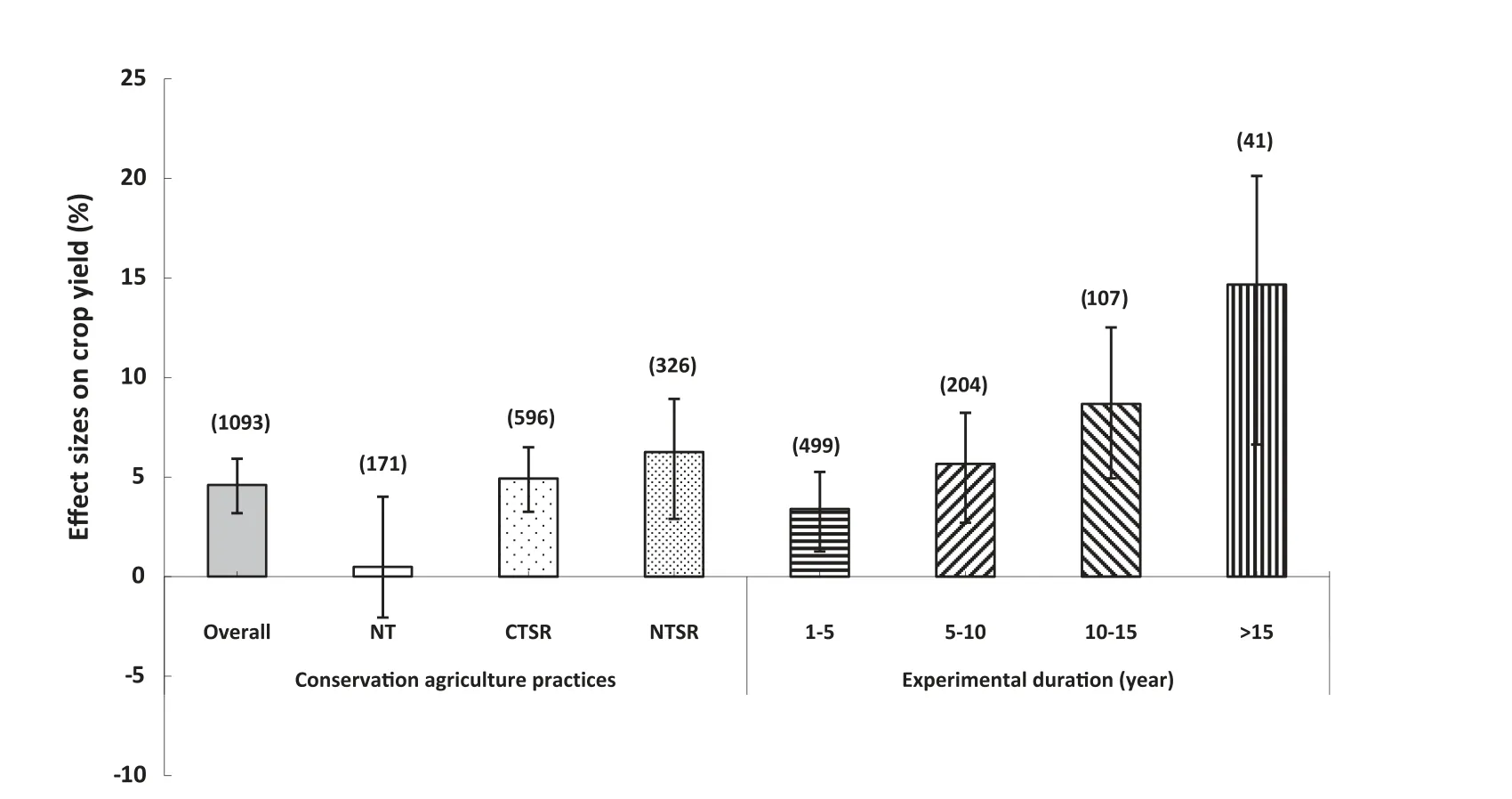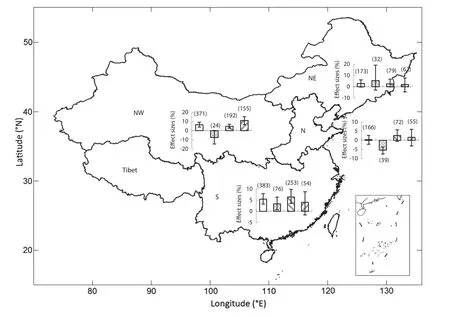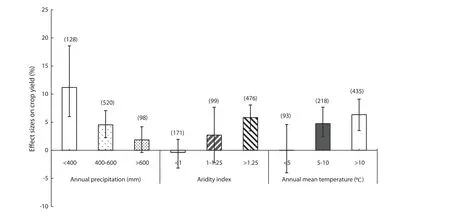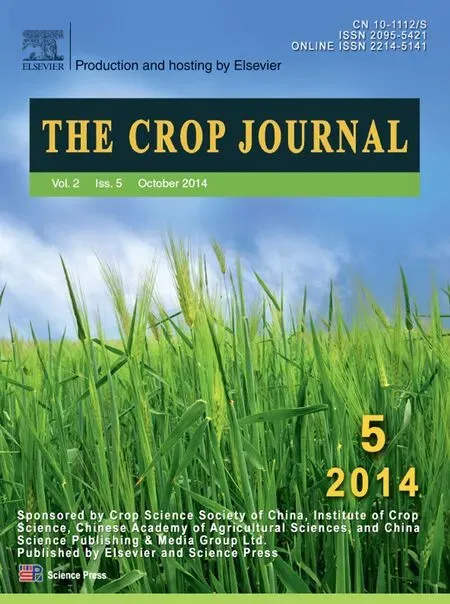The impacts of conservation agriculture on crop yield in China depend on specific practices,crops and cropping regions
Chengyan Zheng,Yu Jiang,Changqing Chen,Yanni Sun,Jinfei Feng,Aixing Deng,Zhenwei Song,Weijian Zhang,,*
aInstitute of Crop Science,Chinese Academy of Agricultural Sciences,Ministry of Agriculture,Beijing 100081,China
bInstitute of Crop Science,Key Laboratory of Crop Physiology&Ecology,Ministry of Agriculture,Beijing 100081,China
cInstitute of Applied Ecology,Nanjing Agricultural University,Nanjing 210095,China
1.Introduction
Conservation agriculture(CA)is recommended as a practice for sustainable crop production that simultaneously preserves soil and water resources [1,2].Generally,CA relies on three major principles: maintenance of a permanent vegetative cover or mulch on the soil surface,minimal soil disturbance(no/reduced tillage) and diversified crop rotation [3].Given the positive effects of CA on soil and water conservation,environmental health,and economic viability,it has been regarded as an environment-friendly technology and has been applied worldwide[4–6].However,given the increasingly serious situation of food security worldwide,concerns are arising about the impacts of CA practices on crop yield,especially in the developing countries[4].
The effects of CA on crop yield can be variable [7].For example,CA may increase crop yield through improving soil fertility by conserving soil and water and sequestering organic carbon in farmland soils[8–10].On the other hand,CA may also have detrimental impacts on crop yield by altering soil physiochemical and biological conditions,such as decreasing soil temperatures in areas of high latitude and seasons with low temperature,and aggravating weed and disease incidence[11–13].The realistic effects of CA on crop yield may depend largely on specific CA practices,regional climate characteristics,and cropping systems[2,14,15].
As the largest developing country,China shows great variation in regional climates and cropping systems.Since the 1970s,great efforts have been made in research on and demonstration of CA in the country.The total area of Chinese farmland under CA was more than 6.6 × 106ha in 2012 [16],but the ratio of farmland area under CA to total cropland area in China is still lower than those in the U.S.and Canada.The key factor limiting the application of CA in China is the persistent uncertainty about the actual impacts of CA on crop yield [17,18].For example,He et al.[19] reported that winter wheat and summer maize yields tended to be higher under no/reduced tillage(NT)than conventional tillage without crop straw retention (CT),especially in dry years.Chen et al.[20]found that NT significantly decreased maize yield,whereas Huang et al.[21]found that rice yields were equal between NT and CT.Wang et al.[22]reported that crop yield was generally higher under no/reduced tillage with straw retention (NTSR)than under CT in dry years,but lower in wet years.Liu et al.[23] found that NTSR increased soybean yield,but reduced maize yield relative to CT.Given that ensuring food security is the first issue of Chinese crop production,quantifying the impacts of CA on crop yield is necessary for CA application in China.
Meta-analysis is a quantitative method used to integrate the results from many independent studies while attempting to estimate the direction and magnitude of treatment effects[24].During the past decades,hundreds of CA experiments have been conducted in different regions and cropping systems in China.However,the actual impacts of CA in China have not been well documented.Based on these field experiments,we accordingly conducted a meta-analysis to quantify the effects of CA on crop yield under specific CA practices,regional climate patterns,and crop types in China.Our objectives were to investigate (i) the overall effects of CA on crop yield and (ii) the manner in which effect sizes vary with specific CA practices,experimental durations,climate patterns,and crop types.
2.Materials and methods
2.1.Data collection
In this study,we focused only on field experiments with a multiple-year experimental duration (>5 years),because farming impacts on crop production are stable and credible only after at least five years.The data were all obtained from peer-reviewed literature published in both Chinese and English journals before May 2013.Articles in Chinese were collected from the Chinese Journal Net full-text database(CJFD),and those in English were from the Science Citation Index of the Institute for Scientific Information.In total,76 published papers were included,consisting of 123 paired trials(Table S1).Detailed information about the experimental sites (Fig.1) is shown in supplemental material.Each paired trial was categorized by six groups: specific CA practices,annual precipitation,annual mean temperature,aridity index,experimental duration,cropping regions,and crop types.
Given the data available,three CA practices were included in the present study: NT: no/reduced tillage only,conventional tillage with straw retention(CTSR),and NT with straw retention(NTSR).The numbers of NT,CTSR,and NTSR trials contributed 19.0% (n = 23),43.0% (n = 52),and 38.0% (n = 46) to the total,respectively,including the major grain crops (rice,wheat,and maize).Conventional tillage without straw retention (CT)was taken as the control.Seasonal yield data were used to determine the differences in the effect sizes of CA practices between crops.Chinese major cropping areas were divided into four regions:Northeast,Northwest,North,and South[18].In Northeast China,the mean temperature averages 4.9 °C(from-0.5 °C to 11.1 °C),and mean precipitation is about 600 mm [25].In Northwest China,the annual temperature averages 7.5 °C (from 1 °C to 14.9 °C),and the precipitation is less than 200 mm [26].The North China Plain has a warm,semi-humid continental monsoon climate with mean annual temperature ranging from 8 °C to 15 °C [27].Annual precipitation is extremely variable,ranging from 300 to 1000 mm,with an average of about 500 mm in North China [28].The main cropping system is an annual winter wheat–summer maize rotation in North China.In South China,the mean annual temperature and annual precipitation are above 15 °C and 800 mm,respectively,and double rice cropping and rice–wheat or rice–rape rotation system dominate in South China.The experimental durations of >5 years of CA were grouped into four categories: 1–5,5–10,10–15,and >15 years.Annual crop yield data were used to compare the CA effect sizes as affected by experimental durations.To compare the differences in CA effect sizes between climate patterns,annual precipitation,mean annual temperature,and aridity indexes in the tested areas were divided into three categories each: <400,400–600,and >600 mm,<5,5–10,and >10 °C,and <1,1–1.25,and >1.25,respectively[29].
2.2.Meta-analysis
The effect size(Li)was calculated as the natural logarithm of the response ratio (R),which is the crop yield under CA practices (NT,CTSR,and NTSR) divided by that under CT.Studies lasting several years or seasons were represented by several observations as annual and seasonal yield,respectively,in the data set [15].Studies were weighted by observation numbers: Wi= n where Wiis the weight for the effect size from the ith paired trial and n is the number of observations.Mean effect sizes were estimated as∑(Li× Wi) / ∑Wi,with Lidenoting the effect size from the ith paired trial,and Wias defined above.
The data were analyzed using MetaWin 2.1 software [30].Bias-corrected 95% confidence intervals (CIs) were calculated for each mean effect size by a bootstrapping procedure (4999 iterations)[31].To ease interpretation,the results in ln R were back-transformed and reported as percentage changes under CA relative to CT ([R-1] × 100).Means were considered to be significantly different from one another if their 95% CIs did not overlap,and were significantly different from zero if the 95% CIs did not contain zero [31].Positive mean effect sizes indicate an increase in crop yield caused by CA,whereas negative values indicate a decrease.
3.Results
3.1.Differences in CA effect sizes among practices and durations
The overall and actual effects of the specific CA practices are presented in Fig.2.Taking all specific practices as an overall effect,CA significantly increased crop yield by 4.6%compared to CT(Fig.2).However,there were large differences in specific effect sizes among the CA practices(P <0.05).The yield gains of CTSR and NTSR were 4.9% and 6.3%,respectively,whereas there was no significant effect in NT compared to CT.The longer the experimental duration of CA,the higher was the magnitude of the increase in crop yield(P <0.01,Fig.2).After five years of experimental duration,CA mostly increased crop yield.
3.2.Differences in CA effect sizes among cropping regions
There were significant differences in CA effect sizes among cropping regions (Fig.3).According to the overall effect of all practices,CA enhanced crop yield by 6.4% and 5.5% in the Northwest and South,respectively,compared to CT,whereas no significant effects were found in the North and Northeast(P <0.05).For NT,crop yield was 3.4% higher in the South and 5.4% lower in the North compared to CT,whereas no significant effects were found in the Northeast or the Northwest(P <0.01).Straw retention showed a positive effect on crop yield in all study regions (Fig.3).The effect sizes of CTSR were 6.4% and 4.8% relative to CT in the South and the Northwest,respectively,with no significant positive effects in the Northeast or the North.Crop yield was 11.0%higher under NTSR than under CT in the Northwest,whereas no significant effects were observed in other regions(P <0.05).
3.3.Differences in CA effect sizes among climate patterns
Rice is planted in South and North China.However,in the North there were no field experiments with multiple-year experimental duration.For this reason,data for rice fields were excluded in the comparison of effect sizes among climate patterns.There were significant differences in CA effect sizes on crop yield among annual precipitation levels(P <0.05,Fig.4).According to the overall effect of all CA practices,the effect sizes of CA practices decreased with increasing annual precipitation.Significant positive effects occurred in areas with annual precipitation below 600 mm,whereas no marked effects were found when precipitation was above 600 mm.Furthermore,the effect sizes of CA practices increased with aridity index (P <0.05).When the aridity index is greater than 1.25,the overall CA effects on crop yield in China are most likely positive (Fig.4).Meanwhile,the higher the mean annual temperature,the higher were the positive effects on crop yield under CA,although the differences were not significant between the temperature ranges (Fig.4).The highest enhancing effects on crop yield occurred when mean annual temperature was higher than 10 °C,whereas the effect was not significant when mean annual temperature was lower than 5 °C.
3.4.Differences in CA effect sizes among crop types
Large differences in CA effect sizes were found among specific crops(P <0.05,Fig.5).According to the overall effect of all practices,CA significantly increased rice,wheat and maize yields by 4.1%,2.9%,and 7.5%,respectively,compared to CT.The highest increase was found for maize.According to the effect of each practice,however,there were no significant effects of NT on the three crop yields.For all three crops in the study,straw retention showed a positive effect on crop yield (Fig.5).Rice and maize yields were significantly increased by 5.0% and 8.4% under the CTSR as compared to the CT,respectively,and wheat yield was increased by only 3.0% not a significant effect.NTSR significantly increased wheat and maize yields by 4.9% and 9.4% compared to CT,respectively,but rice showed no significant effect.Accordingly,CA in China may benefit mainly maize cropping for high yield.
4.Discussion
In the present study,the effects of CA on crop yield were significantly different among specific practices,regional climates,and crop types.Similarly,recent studies have also shown that impacts of CA on crop yield could be positive or negative.For example,positive effects of CA on crop yield were observed in the U.S.,Australia,India,and Canada[5,32,33].However,negative effects were observed in Europe[15].DeFelice et al.[34] also reported that there were large variations in CA effects on crop yield between cropping regions in the U.S.and Canada.To avoid negative impacts of CA on crop productivity,specific CA practices should be used in specific regions and crops.

Fig.1-Locations of field experiments in the collected literature.

Fig.2-Differences in effect sizes among conservation agriculture practices and among experimental durations.Overall,NT,CTSR,and NTSR denote the integrated effects of the three practices,the effects of no/reduced tillage,the effects of conventional tillage with straw retention,and the effects of no/reduced tillage with straw retention,respectively.Bars show 95%bias confidence intervals.Numbers of observations are indicated in parentheses above the bars.
No significant effect of NT on crop yield was found in China (Fig.2).Rusinamhodzi et al.[35] found that NT had no significant effect on maize yield under rainfed conditions.Putte et al.[15] also showed that the introduction of NT in Europe may indeed have exerted negative effects and had reduced crop yield by an average of 8.5%.Continuous NT decreased crop yield in North China(Fig.3),probably owing to the high precipitation.Wang et al.[36] also showed that NT was a promising practice only in low-precipitation conditions in northern China.However,continuous NT was not recommended and NT showed more prominent benefits when combined with residue retention than did NT alone [36].NT with crop residue mulching can not only markedly improve soil moisture conditions,but also increase organic carbon and nutrient inputs into the soil [10].Thus,it would be better to apply NT plus straw mulching to avoid potential negative effects of NT on crop yield.

Fig.3-Differences among cropping regions in sizes of effect of conservation agriculture practices on crop yield.NT,CTSR,NTSR,and overall denote no/reduced tillage,conventional tillage with straw retention,no/reduced tillage with straw retention,and their integrated effects of the three practices respectively.NE,NW,N,and S denote Northeast,Northwest,North,and South,respectively.Bars show 95%bias confidence intervals.Numbers of observations are indicated in parentheses above the bars.

Fig.4-Differences in the effect sizes of conservation agriculture among precipitation,aridity index,and air temperature levels.Bars show 95%bias confidence intervals.Numbers of observations are indicated in parentheses above the bars.
Among the CA methods applied in China,straw retention(CTSR and NTSR) showed a significant positive effect on crop yield (Fig.2).Generally,straw retention improves aggregate stability,reduces soil erosion,and increases the infiltration and conservation of soil water,thus enhancing soil productivity[19,37,38].Additionally,straw retention directly increases the input of organic matter and nutrients into soil,in turn improving soil nutrient availability for crop growth [12,39,40].On the other hand,straw retention may cause poor crop germination by reducing soil temperature and excessively increasing soil moisture,resulting in reductions in crop yield[11,13,41].In addition,straw retention may depress crop growth by nutrient immobilization in soil microbes and increases in residue-borne diseases [12,42,43].However,despite the potential negative effects of straw retention on crop growth,the benefits derived from improved soil fertility and water availability may offset the negative factors[5,9].In this study,there were significant differences in the effect sizes of straw retention among cropping regions(Fig.3).The effect of straw retention on crop yield depended largely on climate conditions and crop types (Figs.4,5).For example,straw retention improves soil moisture conditions by improving soil structure and reduces soil water evaporation,thus benefiting crop growth under dry conditions [19]; however,straw retention in areas with high rainfall may lower crop yield owing to waterlogging[35].Similar results were found by Li et al.[38] and De Vita et al.[44],who reported significantly higher wheat yield under straw retention than under CT only in dry years.Thus,in our study,straw retention significantly increased crop yield in low-precipitation areas (Northwest China).In areas or seasons with high temperature,straw retention can reduce soil temperature and its variation,benefiting crop production[45].Furthermore,high temperature can promote straw decomposition and nutrient release,thereby alleviating microbial nutrient immobilization[46].However,in areas or seasons with low temperature,straw retention may cause poor germination and delay crop growth by preventing soil warming [11,47].A study has shown low nutrient availability under straw retention due to slow nutrient mineralization at cold soil temperatures [48].Thus,straw retention enhanced crop yield in South China as compared to CT,whereas no significant effects were found in North and Northeast China.Straw retention significantly increased maize yield compared to CT,with no significant effect for wheat(Fig.5).Straw retention may cause poor germination of winter wheat and delay crop growth [41,47].Chen et al.[41] reported that lower soil temperature under straw retention in spring delayed the development of winter wheat up to 7 days,on average reducing final grain yield by 7% compared to treatments without straw retention over five seasons.In contrast,cooler soil temperatures and greater soil water content under straw retention are likely to be beneficial for the growth of summer maize[49].

Fig.5-Differences among rice,wheat and maize in sizes of effect of conservation agriculture practices on crop yield.NT,CTSR,NTSR,and overall denote no/reduced tillage,conventional tillage with straw retention,no/reduced tillage with straw retention,and the integrated effects of the three practices,respectively.Bars show 95%bias confidence intervals.Numbers of observations are indicated in parentheses above the bars.
In agreement with the previous studies,the size of effect of CA on crop yield increased with experimental duration[19,34].Based on many long-term field experiments,Farooq et al.[7]also showed that crop yield produced with CA improved over time relative to CT.These relative yield increases over time have been attributed to improved soil conditions under residue retention,such as organic carbon,soil enzyme activity,microbial biomass,porosity and structural stability [7,10].However,Kirkegaard [42] reported no significant yield differences between CA practices and CT and even a declining trend under CA over time,owing mainly to the failure to control weeds and diseases.Thus,long-term impacts of CA on crop yield may depend on the balance between the positive effects of soil fertility improvement and the negative effects of aggravating weed and disease stresses.
Apart from the factors discussed above,the effects of CA on crop yield also depend heavily on other management practices,such as fertilization,machinery,soil type,and timely weeding[7,15,35].For example,Alvarez and Steinbach[50]reported that NT without N addition might decrease maize yield,but that NT with N addition could maintain maize yield compared to CT.Improper seeding equipment or its application can result in lower yields with CA compared to CT,while in other regions the use of appropriate seeding methods can lead to marked yield benefits under CA practices[2].In addition,even if CA practices have no positive effects on crop yield in some areas,they are still meaningful [17].They have been recommended as an environment-friendly technology that is very effective in reducing soil erosion and water loss [8,36].Furthermore,CA helps in the reduction of energy and labor inputs,resulting in lower greenhouse gas emissions [2,7],and is also beneficial in increasing the sustainability of agriculture[1,2].
5.Conclusions
In summary,there are great variations in the impacts of CA practices on crop yield.These impacts depend on the prevailing air temperature and precipitation.There are large temporal and spatial variations in air temperature and precipitation in China.Ensuring food security is the most important issue in the country.Thus,to exploit the advantages of CA on crop production,specific CA practices should be applied in specific regions and crops according to the annual air temperature and precipitation.No-tillage without straw retention generally increases the risk of yield loss; thus,it should be applied in combination with crop straw retention if high yield is targeted.For wheat production,CA may be not a good option if high yield is targeted.Annually,the most suitable area and crop for CA application are Northwest China and maize.In other areas,CA can be applied in the dry seasons.
This work was jointly supported by the National Key Technology R&D Program of China (2011BAD16B14),the Natural Science Foundation of China (31201179) and the Innovation Program of Chinese Academy of Agricultural Sciences.
Supplementary material
Supplementary material related to this article can be found online at http://dx.doi.org/10.1016/j.cj.2014.06.006.Table S1.Detailed information of experimental sites in the references.
[1] P.R.Hobbs,Conservation agriculture: what is it and why is it important for future sustainable food production? J.Agric.Sci.145 (2007) 127–137.
[2] P.R.Hobbs,K.Sayre,R.Gupta,The role of conservation agriculture in sustainable agriculture,Philos.Trans.R.Soc.B.363 (2008) 543–555.
[3] FAO:Food and Agriculture Organization,http://www.fao.org/ag/ca/7.html 2008.
[4] R.Gupta,K.Sayre,Conservation agriculture in South Asia,J.Agric.Sci.145 (2007) 207–214.
[5] G.A.Thomas,G.W.Titmarsh,D.M.Freebairn,B.J.Radford,No-tillage and conservation farming practices in grain growing areas of Queensland–a review of 40 years of development,Aust.J.Exp.Agric.47(2007) 887–898.
[6] R.Lahmar,Adoption of conservation agriculture in Europe lessons of the KASSA project,Land Use Policy 27 (2010)4–10.
[7] M.Farooq,K.C.Flower,K.Jabran,A.Wahid,K.H.M.Siddique,Crop yield and weed management in rainfed conservation agriculture,Soil Tillage Res.117 (2011) 172–183.
[8] J.M.Holland,The environmental consequences of adopting conservation tillage in Europe:reviewing the evidence,Agric.Ecosyst.Environ.103 (2004) 1–25.
[9] B.Govaerts,M.Fuentes,M.Mezzalama,J.M.Nicol,J.Deckers,J.D.Etchevers,S.B.Figueroa,K.D.Sayre,Infiltration,soil moisture,root rot and nematode populations after 12 years of different tillage,residue and crop rotation managements,Soil Tillage Res.94(2007) 209–219.
[10] E.K.Liu,B.Q.Zhao,X.R.Mei,H.B.So,J.Li,X.Y.Li,Effects of no-tillage management on soil biochemical characteristics in northern China,J.Agric.Sci.148 (2010) 217–243.
[11] C.R.Boomsma,J.B.Santini,T.D.West,J.C.Brewer,L.M.Mcintyre,T.J.Vyn,Maize grain yield responses to plant height variability resulting from crop rotation and tillage system in a long-term experiment,Soil Tillage Res.106(2010)227–240.
[12] G.Kaschuk,O.Alberton,M.Hungria,Three decades of soil microbial biomass studies in Brazilian ecosystems: lessons learned about soil quality and indications for improving sustainability,Soil Biol.Biochem.42(2010) 1–13.
[13] A.Deubel,B.Hofmann,D.Orzessek,Long-term effects of tillage on stratification and plant availability of phosphate and potassium in a loess chernozem,Soil Tillage Res.117(2011) 85–92.
[14] K.E.Giller,E.Witter,M.Corbeels,P.Tittonell,Conservation agriculture and smallholder farming in Africa: the heretics'view,Field Crop Res.114 (2009) 23–34.
[15] A.Putte,G.Govers,J.Diels,K.Gillijns,M.Demuzere,Assessing the effect of soil tillage on crop growth: a meta-regression analysis on European crop yields under conservation agriculture,Eur.J.Agron.33(2010) 231–241.
[16] Conservation agriculture area over 100 million Mu in China,China Sci.Technol.Inform.3(2013) 9(in Chinese).
[17] X.B.Wang,D.X.Cai,W.B.Hoogmoed,O.Oenema,U.D.Perdok,Developments in conservation tillage in rainfed regions of North China,Soil Tillage Res.93(2007) 239–250.
[18] R.Z.Xie,S.K.Li,Y.Z.Jin,X.J.Li,Q.X.Tang,K.R.Wang,S.J.Gao,The trends of crop yield responses to conservation tillage in China,Sci.Agric.Sin.41(2008) 397–404 (in Chinese with English abstract).
[19] J.He,H.W.Li,R.G.Rasaily,Q.J.Wang,G.H.Cai,Y.B.Su,X.D.Qiao,L.J.Liu,Soil properties and crop yields after 11 years of no tillage farming in wheat–maize cropping system in North China Plain,Soil Tillage Res.113 (2011) 48–54.
[20] Y.Chen,S.Liu,H.Li,X.F.Li,C.Y.Song,R.M.Cruse,X.Y.Zhang,Effects of conservation tillage on corn and soybean yield in the humid continental climate region of Northeast China,Soil Tillage Res.115 (116) (2011) 56–61.
[21] M.Huang,Y.B.Zou,P.Jiang,B.Xia,Y.H.Feng,Z.W.Cheng,Y.L.Mo,Effect of tillage on soil and crop properties of wetseeded flooded rice,Field Crops Res.129 (2012) 28–38.
[22] X.B.Wang,K.A.Dai,D.C.Zhang,X.M.Zhang,Y.Wang,Q.S.Zhao,D.X.Cai,W.B.Hoogmoed,O.Oenema,Dryland maize yields and water use efficiency in response to tillage/crop stubble and nutrient management practices in China,Field Crops Res.120 (2011) 47–57.
[23] S.Liu,J.Y.Yang,X.Y.Zhang,C.F.Drury,W.D.Reynolds,G.Hoogenboom,Modelling crop yield,soil water content and soil temperature for a soybean–maize rotation under conventional and conservation tillage systems in Northeast China,Agric.Water Manag.123 (2013) 32–44.
[24] J.Gurevitch,L.V.Hedges,Statistical issues in ecological meta-analyses,Ecology 80(1999) 1142–1149.
[25] C.Q.Chen,C.R.Qian,A.X.Deng,W.J.Zhang,Progressive and active adaptations of cropping system to climate change in Northeast China,Eur.J.Agron.38(2012) 94–103.
[26] Q.Meng,P.Hou,L.Wu,X.Chen,Z.Cui,F.Zhang,Understanding production potentials and yield gaps in intensive maize production in China,Field Crops Res.143(2013) 91–97.
[27] R.P.Guo,Z.H.Lin,X.G.Mo,C.L.Yang,Responses of crop yield and water use efficiency to climate change in the North China Plain,Agric.Water Manag.97(2010) 1185–1194.
[28] J.Li,S.Inanaga,Z.Li,A.E.Eneji,Optimizing irrigation scheduling for winter wheat in the North China Plain,Agric.Water Manag.76 (2005) 8–23.
[29] M.Meng,J.Ni,Z.G.Zhang,Aridity index and its applications in geo-ecological study,Acta Phytoecol.Sin.28(2004)853–856(in Chinese with English abstract).
[30] M.S.Rosenberg,D.C.Adams,J.Gurevitch,Metawin:Statistical Software for Meta-Analysis,Version 2.1,Sinauer Associates,Inc.,Sunderland,2000.
[31] B.Linquist,K.J.Groenigen,M.A.Adviento-Borbe,C.Pittelkow,C.Kessel,An agronomic assessment of greenhouse gas emissions from major cereal crops,Global Change Biol.18(2012) 194–209.
[32] F.E.Miguez,G.A.Bollero,Review of corn yield response under winter cover cropping systems using meta-analytic methods,Crop Sci.45(2005) 2318–2329.
[33] O.Erenstein,Cropping systems and crop residue management in the Trans-Gangetic Plains:issues and challenges for conservation agriculture from village surveys,Agric.Syst.104(2011)54–62.
[34] M.S.DeFelice,P.R.Carter,S.B.Mitchel,Influence of tillage on corn and soybean yield in the United States and Canada,Crop Manag.(2006),http://dx.doi.org/10.1094/CM-2006-0626-01-RS(Online).
[35] L.Rusinamhodzi,M.Corbeels,M.T.Wijk,M.C.Rufino,J.Nyamangara,K.E.Giller,A meta-analysis of long-term effects of conservation agriculture on maize grain yield under rain-fed conditions,Agron.Sustain.Dev.31(2011) 657–673.
[36] X.Wang,H.J.Wu,K.A.Dai,D.C.Zhang,Z.H.Feng,Q.S.Zhao,X.P.Wu,K.Jin,D.X.Cai,O.Oenema,W.B.Hoogmoed,Tillage and crop residue effects on rainfed wheat and maize production in northern China,Field Crops Res.132(2012)106–116.
[37] J.He,N.J.Kuhn,X.M.Zhang,X.R.Zhang,H.W.Li,Effects of 10 years of conservation tillage on soil properties and productivity in the farming–pastoral ecotone of Inner Mongolia,China,Soil Use Manag.25(2009) 201–209.
[38] H.W.Li,H.W.Gao,H.D.Wu,W.Y.Li,X.Y.Wang,J.He,Effects of 15 years of conservation tillage on soil structure and productivity of wheat cultivation in northern China,Aust.J.Soil Res.45(2007) 344–350.
[39] S.P.Qin,X.H.He,C.S.Hu,Y.M.Zhang,W.X.Dong,Responses of soil chemical and microbial indicators to conservational tillage versus traditional tillage in the North China Plain,Eur.J.Soil Biol.46 (2010) 243–247.
[40] Q.J.Wang,Y.H.Bai,H.W.Gao,J.He,H.Chen,R.C.Chesney,N.J.Kuhn,H.W.Li,Soil chemical properties and microbial biomass after 16 years of no-tillage farming on the Loess Plateau,China,Geoderma 144 (2008) 502–508.
[41] S.Y.Chen,X.Y.Zhang,D.Pei,H.Y.Sun,S.L.Chen,Effects of straw mulching on soil temperature,evaporation and yield of winter wheat: field experiments on the North China Plain,Ann.Appl.Biol.150 (2007) 261–268.
[42] J.A.Kirkegaard,A review of trends in wheat yield responses to conservation cropping in Australia,Aust.J.Exp.Agric.35(1995) 835–848.
[43] T.Y.Duan,Y.Y.Shen,E.Facelli,S.E.Smith,Z.B.Nan,New agricultural practices in the Loess Plateau of China do not reduce colonisation by arbuscular mycorrhizal or root invading fungi and do not carry a yield penalty,Plant Soil 331(2010) 265–275.
[44] P.De Vita,E.Di Paolo,G.Fecondo,N.Di Fonzo,M.Pisante,No-tillage and conventional tillage effects on durum wheat yield,grain quality and soil moisture content in southern Italy,Soil Tillage Res.92(2007) 69–78.
[45] H.Blanco-Canqui,R.Lal,Crop residue removal impacts on soil productivity and environmental quality,Crit.Rev.Plant Sci.28(2009) 139–163.
[46] O.C.Devevre,W.R.Horwath,Decomposition of rice straw and microbial carbon use efficiency under different soil temperatures and moistures,Soil Biol.Biochem.32(2000)1173–1785.
[47] C.F.Drury,C.S.Tan,T.W.Welacky,T.O.Oloya,A.S.Hamill,S.E.Weaver,Red clover and tillage influence on soil temperature,water content,and corn emergence,Agron.J.91(1999) 101–108.
[48] J.J.Schoenau,C.A.Campbell,Impact of crop residues on nutrient availability in conservation tillage systems,Can.J.Plant Sci.76(1996) 621–626.
[49] J.B.Zhou,C.Y.Wang,H.Zhang,F.Dong,X.F.Zheng,W.Gale,S.X.Li,Effect of water saving management practices and nitrogen fertilizer rate on crop yield and water use efficiency in a winter wheat–summer maize cropping system,Field Crops Res.122 (2011) 157–163.
[50] R.Alvarez,H.S.Steinbach,A review of the effects of tillage systems on some soil physical properties,water content,nitrate availability and crops yield in the Argentine Pampas,Soil Tillage Res.104 (2010) 1–15.
- The Crop Journal的其它文章
- Productivity,quality and soil health as influenced by lime in ricebean cultivars in foothills of northeastern India
- Genotype × environment interaction effects on early fresh storage root yield and related traits in cassava
- Identification of QTL for adult-plant resistance to powdery mildew in Chinese wheat landrace Pingyuan 50
- Effect of subsoil tillage depth on nutrient accumulation,root distribution,and grain yield in spring maize
- Isolation and characterization of a novel wall-associated kinase gene TaWAK5 in wheat(Triticum aestivum)
- Exp2 polymorphisms associated with variation for fiber quality properties in cotton(Gossypium spp.)

